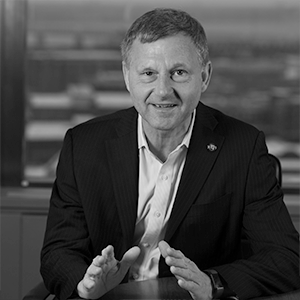How the US Can Secure its Share of the SAF Opportunity
Michael Rossel
Aviation Expert
PA Consulting
Globally, the race to decarbonize aviation is accelerating. With Sustainable Aviation Fuel (SAF) widely recognized as the most viable near-term solution to reduce emissions, how can the US keep pace and meet its goals?
Across the US, we’ve seen signs of positive intent. The SAF Grand Challenge still stands, where the Department of Energy, Department of Transportation, and United States Department of Agriculture together have set goals to reduce the cost, enhance energy security, and expand the production and use of SAF to achieve:
A minimum 50 percent reduction in life cycle emissions compared to conventional fuel
Three billion gallons per year of domestic SAF by 2030
35 billion gallons of SAF to satisfy 100 percent of domestic demand by 2050.
So, the ambition is there—but is the action? To date, adoption and uptake has remained slow, and without decisive action, the US risks losing billions of dollars in investment and thousands of jobs to more proactive markets. PA Consulting’s latest research, Cacophony to Symphony: Successfully scaling sustainable aviation fuel, highlights what needs to happen next.
Drawing on insights from nearly 600 senior leaders across airlines, airports, investors, producers, and policymakers, the report reveals a striking paradox: confidence in SAF’s potential is among the highest worldwide, yet only 19 percent of US stakeholders are actively using or investing in SAF—below the global average. Similarly, while 93 percent of US respondents cite SAF as essential to aviation’s decarbonization efforts, only 34 percent believe widespread adoption will be achieved by 2030.
This divide is even more striking when SAF is seen as achieving more than just sustainability goals: 83 percent of US respondents believe SAF holds promise for job creation in the US. And 59 percent of US-active investors, airlines, and airport respondents see SAF as critical to national energy security.
Yet while there’s a quiet confidence building across the US aviation industry that SAF is an economic opportunity, and not just a climate solution, progress remains fragmented.
To turn optimism into action, the Cacophony to symphony report identifies three key steps to scaling SAF in the US market:
Build the infrastructure backbone
Access to the necessary infrastructure is seen as the single biggest barrier to SAF adoption in the US, with 83 percent of respondents citing lack of distribution and storage capacity as a major hurdle. This is far higher than global peers, and it is clear that a robust network of blending facilities, pipelines, and other distribution networks is essential to ensure that the three-billion-gallon production goal by 2030 can be delivered.
We believe that regional SAF hubs could play a transformative role. By clustering production, blending, and distribution facilities near major airports, the industry can reduce costs and accelerate supply. Coordinated investment from both public and private sectors is essential to ensure that SAF is produced and delivered efficiently to where it’s needed most.
As an example, we look to the Minnesota SAF hub, which aims to produce up to one billion gallons (approximately three million tons) of SAF annually, while advancing next-generation pathways and feedstocks including power-to-liquid and woody biomass. Backed by a powerful coalition—including Delta Air Lines, Bank of America, the State of Minnesota, and others—the hub is developing a full-spectrum SAF ecosystem, from regenerative feedstocks and renewable power to refining, blending, and direct pipeline delivery.
Align policy with market needs
Whilst national incentive measures such as the 45Z Clean Fuels Production Tax Credit have been scaled back and restricted, many states are moving forward with their own incentives, for their own reasons. But the market is still looking for certainty to reduce risk in what is still an emerging industry. For example:
Long-term purchase agreements to provide certainty for prospective producers and investors
Tax incentives and credits that reward early adopters and scale producers
Streamlined permitting processes to reduce delays in building SAF facilities
Access to blending facilities and distribution networks to get their product to market
As the market develops, the risk factors will diminish but the fundamentals remain: availability, quality and price of feedstocks; cost of capital for construction or repurposing of refinery capacity; and the willingness of the market to buy what is likely to remain, at least in the short- to medium- term, a premium-priced product.
Mobilize private sector momentum
Confidence in SAF’s scalability is growing, driven by emerging partnerships and regional innovation: 59 percent of US respondents see SAF as critical to national energy security, and investors increasingly view SAF as a strategic opportunity. Further progress will come if airlines, airports, and fuel producers can collaborate to create demand signals through offtake agreements, joint ventures and new revenue opportunities such as SAF certificates that de-risk investment and catalyse production at scale.
Private sector leadership can also help bridge gaps in infrastructure and technology. For example, partnerships between airlines and energy companies can accelerate the development of new feedstocks, pathways and technologies. Airports have an essential role in bringing together all of the actors in the SAF value chain to make things happen—this is what they do best.
The bottom line
SAF is an incredible economic opportunity for the US. It can strengthen energy security, create thousands of jobs, and position the US as a global leader in sustainable aviation fuel production. But belief must be matched by bold, coordinated action across the entire SAF ecosystem with everyone playing their part.
A whole-systems challenge calls for a whole-systems solution; a symphony of orchestrated action where policymakers, producers, off-takers, and players in the messy middle create the conditions to successfully scale SAF.


